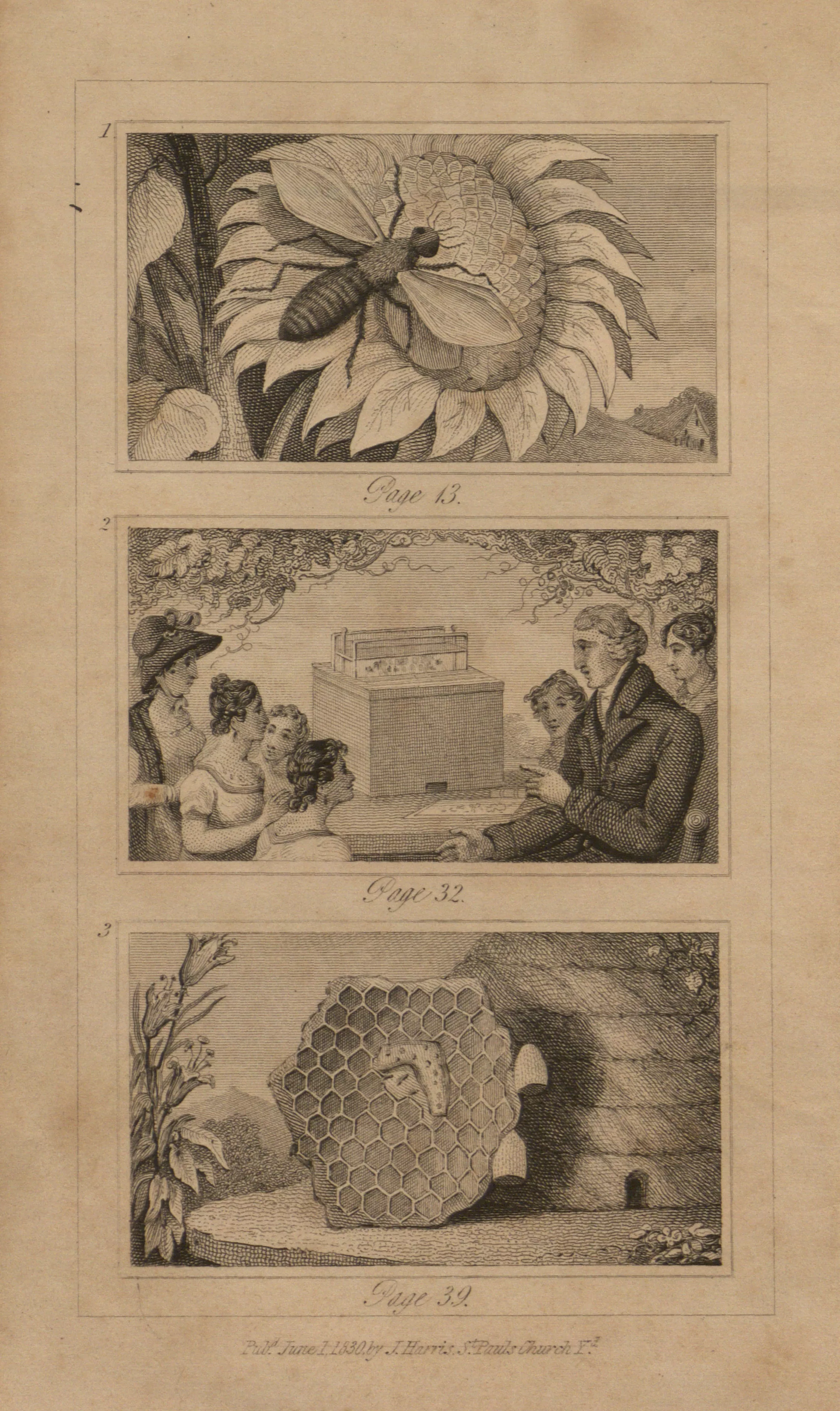Exhibit
Creation Date
1830
Height
12 cm
Width
6 cm
Medium
Description
This illustration consists of three images: the top and bottom images ("1" and "3") depict the natural life of bees, while the middle image portrays the dissemination of knowledge concerning the life of the hive. This image ("2") counteracts the ideologically threatening nature of the beehive—ruled by a female queen and concerned primarily with reproduction—by depicting a male teacher lecturing female students and, significantly, by supplementing or even supplanting the role of the present, female governess.
The top image—labeled "Page 13" below and "1" at its top right corner—depicts a bee on a sunflower; the second, labeled "2" and "Page 32," depicts a lesson given concerning a beehive, and the third, labeled "3" and "Page 39," depicts a cross-section of a hive. The most convoluted image is the second: A man in a black coat is seated to the right of a table, pointing at the box-shaped beehive on it. A screen has been drawn out of the hive and rests on the table in front of him. To the left of the table are three young women in white dresses, seated, and their governess, who stands. She wears a white dress with a dark hat and shawl. Behind the man and to his left are two more young women. Foliage, resembling grape vines, arches above the party.
Images like this one were meant to give children a visual context for the content of their lessons and to create the proper association between an object and its symbolic function.
The perception and symbolic nature of bees changed significantly between the mid-eighteenth century and the nineteenth. For much of the eighteenth century bees were popular among authors and aristocrats alike; the former found them an excellent symbol of industry and political order, and the latter simply found them diverting, constructing glass hives in order to observe them more closely (Johnson 266; Coleman 107). By the end of the century, however the insect had fallen out of favor as a gentle distraction, as their association with prolific reproduction was increasingly seen as unsuitable. The hive’s use as a symbol of political order (on account of its organization as a community under a single ruler) faded as well; as the distinction between public and private solidified—with women consigned almost entirely to the private—the idea of a matriarchal hive became increasingly uncomfortable. As a result, the hive’s symbolic nature shifted towards a representation of the bonds between mother and daughter (Coleman 115). Though this idea never fully replaced the older notion of the hive as an exemplary hierarchal system, bees became a less self-explanatory icon in the nineteenth century than they had been previously.
Given the sexually fraught symbolic nature of bees at the beginning of the nineteenth century, the scene shown here can be viewed as an attempt to reclaim the masculine power of the hive. Unlike many hives kept as hobbies around this time, the hive is opaque, preventing the women from potentially seeing anything specifically related to breeding. By giving the role of knowledgeable instructor to the picture’s only male figure, the mystery of the hive's actions are channeled through masculine power. As presumed keeper of the hive he has life-or-death power over the bees, and without him they would remain unknown entities to the women in his audience. His black coat makes him the focal point of the image, while the women—who share their sex with the hive’s most important inhabitant—are dressed in white and almost fade into the background. This effort to masculinize the nature of the hive through visual means shows the extent to which gender concerns were felt in the context of education, even when the material was meant for mixed audiences.
Collection
Accession Number
RTYMG J651 1830 Bee Collection
Additional Information
Bibliography
Coleman, Deirdre. "Entertaining Entomology: Insects and Insect Performers in the Eighteenth Century." Eighteenth-Century Life 30.3 (2006): 107-134. Print.
Milne, Ann. "Fables of the Bees: Species as an Intercultural Discourse in Eighteenth-Century Scientific and Literary Texts." L'Esprit Createur 46.2 (2006): 33-41. Print.
Johnson, James W. "The Neo-Classical Bee." Journal of the History of Ideas 22.2 (1961): 262-66. Print.
Prete, Frederick R. "Can Females Rule the Hive? The Controversy over Honey Bee Gender Roles in British Beekeeping Texts of the Sixteenth-Eighteenth Centuries." Journal of the History of Biology 24.1 (1991): 113-144. Print.

